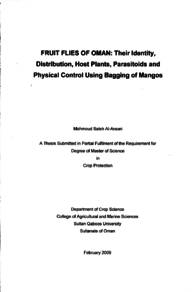Document
Fruit flies of Oman : their identity, distribution, host plants, parasitoids and physical control using bagging of mangos
Publisher
Sultan Qaboos University
Gregorian
2009
Language
English
Subject
English abstract
Fruit flies are the most destructive insect pests attacking many types of fruits in Oman causing serious damage. A survey was carried out to determine which species are present, their abundance, and their host range. In addition, bagging of fruits and the presence of biological controls, as more effective and environmentally safer alternative control methods to the currently- practiced insecticide-based control methods, was investigated.
In this study, Tephritid fruit flies were surveyed using male lure (methyl eugenol) traps and by collection of host fruits over 3 years (May 2003-September 2006) in 100 sites from different regions of Oman. Six fruit fly species, Bactrocera zonata, B. Oleae, Dacus ciliatus, D. longistylus, Carpomya incompleta and C. vesuviana, were collected and identified from 54 host plants. Five species, B. zonata, B. oleae, D. ciliatus, C. vesuviana, and C. incompleta, were of economic importance. The species most common in traps was B. zonata and was the only generalist species. Fruit flies were reared from 20 out of 35 sampled commercial plant species. The two export crops (lime and dates) were not hosts for any of these fruit fly species.
Data from bagging experiment to protect 5 different mango cultivars, Zafaran, Rasfory, Totapuri, Omani and Hindi-Abosenara, from fruit fly showed that there was significant difference between bagged and unbagged fruits. The three bagging treatments significantly protected the fruits from fruit fly attacks compared to control un-bagged fruits (F= 76.09, P= 4.45E-08). The comparison among the three treatments showed that newspaper and agril were more efficient than green mesh bags.
Two parasitoids, Opius sp. and Eucoiline, were reared and identified in the study. However, their effictivness as biological control agents against remains to be investigated.
Data from this study emphasise the need for use of effective control methods and implementation of strict quarantine measures against fruit fly pests that can complicate the development of fruits and vegetables production and export industry.
Member of
Resource URL
Arabic abstract
تعتبر ذبابة الفاكهة أكثر آفة حشرية مدمرة تصيب العديد من الفواكه، مسببة خسائر كبيرة في سلطنة عمان. ولذلك قمنا بدراسة لتحديد أنواع ذبابة الفاكهة المتواجدة، ومدی انتشارها، و نوع الفواكه العائلة سواء أكانت ذات قيمة تجارية أو لا، و تقصي طرق بديلة اللمبيدات الحشرية المكافحة لهذه الآفة.
وقد قمنا بعمل مسح لذبابة الفاكهة باستخدام مصائد فرمونية جاذبة ذكرية، وجمع ثمار النباتات من ۱۰۰ موقع من مختلف مناطق السلطنة على مدار 3 سنوات (من مايو ۲۰۰۳ حتى سبتمبر ۲۰۰۹م).
تم من خلاله جمع ۳۰۰ عينة لأربع وخمسين نوع من الفاكهة. وقد تم التعرف على ست أنواع من ذبابة الفاكهة ,Bactrocera zonata
, B . oleae , Dacus ciliatus , D . longistylus, Carpomya incompleta and C. vesuviana, خمس منها, B . zonata , B . Oleae , D . ciliatus , C . vesuviana and C . incompleta ذات تأثير اقتصادي.
كما أنه وجد أن النوع B . zonata هو الأكثر شيوعا و انتشارا. ووجدت ذبابة الفاكهة في ۲۰ من 35 فاكهة تجارية، وجدير بالذكر أنه لم يلاحظ إصابة أيا من ثمار النخيل أو الليمون بهذه الآفة. وفي محاولة لإيجاد بدائل مكافحة أكثر فعالية وأمنة بيئيا قمنا بتقصي كفاءة تكييس الثمار و البحث عن طفيليات محليه لذبابة الفاكهة. وأشارت نتائج تجربة تغليف ثماره اصناف من ثمار المانجو إلى أن التغليف يحمي الثمار مقارنتا بعدم تغليفها. كما أنه مقارنة 3 أنواع من الأكياس أظهرت أن ورق الجرائد وغلاف الأجرل أكثر فعالية من غلاف الشبك الأخضر . تم تعريف نوعين من الطفيليات (Opius sp. and Eucoiline) ولكن لم يتم دراسة جدوى استعمال الطفيليين كوسيلة مكافحة حيوية فاعلة. وأشارت النتائج المتحصل عليها من هذه الدراسة إلى الحاجة إلى مزيد من إجراءات المكافحة والحجر الزراعي الفاعلة لهذه الآفة التي بدورها تحد من إنتاج وتطوير عملية تصدير الفواكه والخضروات.
وقد قمنا بعمل مسح لذبابة الفاكهة باستخدام مصائد فرمونية جاذبة ذكرية، وجمع ثمار النباتات من ۱۰۰ موقع من مختلف مناطق السلطنة على مدار 3 سنوات (من مايو ۲۰۰۳ حتى سبتمبر ۲۰۰۹م).
تم من خلاله جمع ۳۰۰ عينة لأربع وخمسين نوع من الفاكهة. وقد تم التعرف على ست أنواع من ذبابة الفاكهة ,Bactrocera zonata
, B . oleae , Dacus ciliatus , D . longistylus, Carpomya incompleta and C. vesuviana, خمس منها, B . zonata , B . Oleae , D . ciliatus , C . vesuviana and C . incompleta ذات تأثير اقتصادي.
كما أنه وجد أن النوع B . zonata هو الأكثر شيوعا و انتشارا. ووجدت ذبابة الفاكهة في ۲۰ من 35 فاكهة تجارية، وجدير بالذكر أنه لم يلاحظ إصابة أيا من ثمار النخيل أو الليمون بهذه الآفة. وفي محاولة لإيجاد بدائل مكافحة أكثر فعالية وأمنة بيئيا قمنا بتقصي كفاءة تكييس الثمار و البحث عن طفيليات محليه لذبابة الفاكهة. وأشارت نتائج تجربة تغليف ثماره اصناف من ثمار المانجو إلى أن التغليف يحمي الثمار مقارنتا بعدم تغليفها. كما أنه مقارنة 3 أنواع من الأكياس أظهرت أن ورق الجرائد وغلاف الأجرل أكثر فعالية من غلاف الشبك الأخضر . تم تعريف نوعين من الطفيليات (Opius sp. and Eucoiline) ولكن لم يتم دراسة جدوى استعمال الطفيليين كوسيلة مكافحة حيوية فاعلة. وأشارت النتائج المتحصل عليها من هذه الدراسة إلى الحاجة إلى مزيد من إجراءات المكافحة والحجر الزراعي الفاعلة لهذه الآفة التي بدورها تحد من إنتاج وتطوير عملية تصدير الفواكه والخضروات.
Category
Theses and Dissertations

